 My investigation of the circumstances surrounding Robert Capa’s images of Omaha Beach on D-Day, June 6, 1944, and the subsequent fate of his negatives, continues apace. I will publish some major findings at the end of this month. In the meantime, I’ll fill in some of the blanks in the story so far.
My investigation of the circumstances surrounding Robert Capa’s images of Omaha Beach on D-Day, June 6, 1944, and the subsequent fate of his negatives, continues apace. I will publish some major findings at the end of this month. In the meantime, I’ll fill in some of the blanks in the story so far.
I’ve taken to interspersing these chapters among posts on other subjects. During the period in which I and some colleagues concentrated here on this subject a baker’s dozen of this blog’s former subscribers unsubscribed, presumably irked by this inquiry in depth. After all, they had to watch the senior photo critic in North America, abetted by some professional colleagues, dismantle a 70-year-old myth that’s permeated the culture. All for free. You can understand their disgruntlement, as I surely do.
Regardless, I’ve soldiered on, as have several of my accomplices. I’ve just read yet another version of the melted-emulsion fable, in Ingrid Bergman’s 1980 autobiography, My Story, and watched filmmaker Steven Spielberg parrot it mindlessly in Robert Capa: In Love and War, Anne Makepeace’s 2002 film for the PBS “Amertican Masters” series. The plot thickens. More to come.
A Magnum of Silence
On July 24 I emailed to Adrian Kelterborn, described as the “lead multimedia producer” for Magnum In Motion (MIM), “the multimedia digital studio of Magnum Photos.” Kelterborn, you will recall, produced the MIM video “Behind the Picture: Robert Capa’s D-Day,” narrated by LIFE‘s picture editor, John Morris, and posted at the TIME website on May 29, 2014.
This video contained faked versions of Capa’s supposedly heat-damaged D-Day negatives. Disclosure of this forgery in a Guest Post at this blog by photographer Rob McElroy forced TIME‘s acknowledgment of the fakes and a rapid re-editing of the video to indicate those forgeries as “photo-illustrations.”
Thinking that Kelterborn deserved the chance to explain himself, I offered him a Guest Post here at Photocritic International, indicating that, if he accepted, I’d send him a list of questions to which he could respond, as I’d done previously with John Morris. To date, I’ve heard nothing from Kelterborn.
Because the making of that video obviously involved interaction with the parent corporation, Magnum Photos, which handles licensing of all of Capa’s images, I decided to clarify the relationship between the two entities, and the licensing procedures. This seemed particularly important since, in its credits for the faked negatives, the revised version of Kelterborn’s video attributes them to “TIME/Magnum Photos.” So, on July 29, I emailed David Kogan, Executive Director of Magnum Photos, a set of questions regarding that agency’s licensing policies and procedures and the relationship between Magnum Photos and Magnum In Motion. He replied as follows:
Dear Mr Coleman
As you may be aware I’ve only recently taken up the role of Executive Director of Magnum which is a somewhat time consuming job. Therefore I can’t devote any time to answering your questions.
Regards
David Kogan
Perhaps some other member of the Magnum conglomerate with a few minutes to spare and some commitment to uncovering the truth — Susan Meiselas, say, or Martin Parr — will volunteer to answer some of those questions. But I’m not holding my breath.
The Fog of War Photography
Subsequent to publishing McElroy’s detailed dissection of the forgeries in the 2014 TIME/Magnum In Motion video, I discovered and wrote about a 2009 TIME video by Craig Duff with a non-Capa image tucked anomalously into a sequence of his Omaha Beach pictures.
It turned out that the image dropped in among selections from Robert Capa’s “magnificent eleven” at 3:59 in that edition of Duff’s video, “The Iconic Photo of D-Day,” constituted a variant of an image shown in full earlier in that video (at 1:34).
But it wasn’t by Capa. It came from the National Archives, credited to an unidentified U.S. Coast Guard photographer; bears the title “Omaha Beach First Wave” and the ID number Official photograph 26-G-2337; and shows landing craft putting first-wave troops ashore. They attribute it tentatively to U.S. Coast Guard First Photographers Mate Robert Sargent, best known for the image titled “Into the Jaws of Death,” made a few minutes later. (The print of it in their files has the name “Sargent” written across its back.)
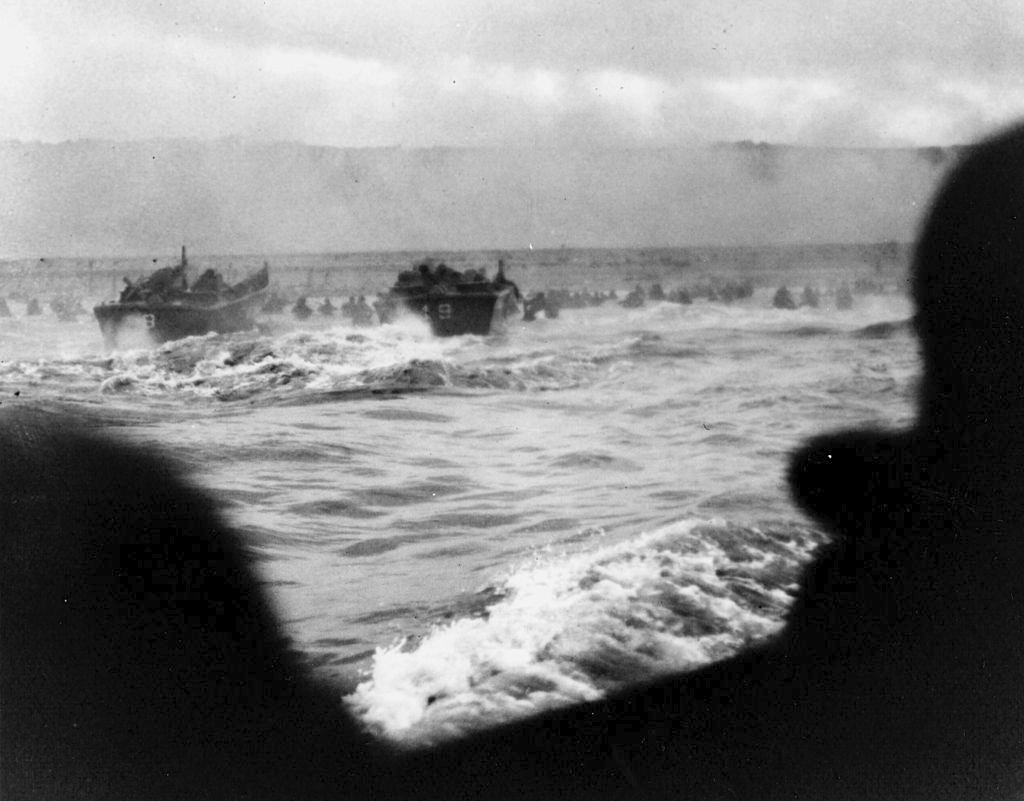
Robert Sargent, US Coast Guard First Photographers Mate, “Landing craft put troops ashore on Omaha Beach,” first wave, 6-6-44. Courtesy National Archives.
My thanks to blogger Peter Marshall and reader Bill Barrett for identifying the image, and to Barrett for going one step further by contacting the National Archives to nail down the attribution insofar as possible. No version of the image that I’ve found online — forinstance, this one at Wikipedia — resembles the one in Duff’s video, which appears to have been lightened (presumably to make it less conspicuously different from the exposures that surround it.) Additionally, the dark masses in the foreground, left and right, appear to have undergone some digital revision — the addition of some light streaks that change their contours.
I offered Duff a Guest Post for the purpose of explaining this. He declined the offer, in an August 4 email that says,
Dear Mr. Coleman,
I called the number you have listed below your name on your emails, and left a message more than a week ago. Perhaps you did not receive it. I would have been happy to chat about this with you on the phone.
And if you had done me the courtesy ‹ which we expect journalists to do ‹ of reaching out for comment before publication, we could have easily cleared this up.
There is no ethical breach here. Merely a mistake.
I can think of no reason why anyone would intentionally use a photo that was not Capa’s if he had the real ones at his fingertips. This was clearly an unintentional error.
The image you point out was not the photograph that was in the original piece as I recall it running in 2009. I suspect something got mis-linked when the piece was re-encoded later when the iPad came out and required a difference codec. That would account for the sloppiness of how it is presented. (I recall being very careful to get the black lines between the images to be even.) But I cannot know for sure.
I have corrected the mistake and made a note on my blog.
And I will not comment on any quarrel you have with Ms. Young. That’s between you and her. [I’d asked if Cynthia Young, Curator of the Capa Archives at the International Center of Photography, who serves as the narrator for this video, had seen and approved that insertion.]
Yours sincerely,
Craig Duff
Sure enough, the new version of this video at Duff’s site has that Coast Guard image removed from Capa’s Omaha Beach sequence. The accompanying note reads, “An earlier upload of this piece had a corrupted timeline which inserted an errant photograph which was not an image made by Robert Capa. This version has been corrected to reflect the piece as it originally ran in 2009.” The version at Vimeo has undergone the same revision; a note there reads, “An earlier upload of this piece mistakenly included an image that was not Robert Capa’s. It has been corrected.”
I replied the same day, as follows:
Dear Mr. Duff:
Apologies for not retrieving sooner your voicemail response to my email.
I’m pleased to see that you’ve removed the Coast Guard photograph from the sequence of Robert Capa’s D-Day images made on Omaha Beach in the latest version of your video as posted at your own blog and at Vimeo, with accompanying corrective notes.
I don’t know enough about video production to confirm or argue with your theory that this resulted from a corrupted timeline due to reconfiguration of the digital file. But I’ll take you at your word that it happened inadvertently, not by plan.
That this insertion went unnoticed at your site and Vimeo — and, perhaps, also at the TIME site, if it appeared there in that “corrupted” state — suggests that, even if accidentally, it had the effect of misinforming everyone who saw it, over a period of five years. I’m surprised that no one brought this to your attention, or Ms. Young’s, and that you didn’t discover it yourselves. Who else should get held accountable for this video’s content?
Contrary to your assertion that I should have “done [you] the courtesy (which we expect journalists to do) of reaching out for comment before publication,” it’s not standard practice to contact the subjects of op-ed commentaries and reviews before they appear. To the contrary. Movie reviewers assume that what appears in a given film does so with the director’s intent. I assumed, quite reasonably, that what I saw in your video you’d put there purposefully. The lesson to draw from this: As a video producer, you need to examine your works carefully any time they’re “re-encoded,” especially before you personally undertake their publication online.
I’ll post all this at my blog, so my readers will understand better what happened.
Best,
Allan
Time, and Time Again
The story of the insertion of faked Capa negatives into the 2014 TIME video produced by Magnum in Motion, in collaboration with the Capa Archives at the International Center of Photography, has attracted further attention. The Spanish website Clasesdeperiodismo.com picked it up from PetaPixel on July 2. See “Time rectifica falsificación de negativos de Robert Capa.”
 And, at his blog, Re: Photo, Peter Marshall published his third post responding to this series. He titled it “Can You Help?” because I’d asked him to pass a set of relevant questions along to his UK readers, some of whom might have useful information about the individuals who worked in LIFE‘s darkroom in June 1944. Since some of this blog’s readers may know something pertinent, I repeat them here:
And, at his blog, Re: Photo, Peter Marshall published his third post responding to this series. He titled it “Can You Help?” because I’d asked him to pass a set of relevant questions along to his UK readers, some of whom might have useful information about the individuals who worked in LIFE‘s darkroom in June 1944. Since some of this blog’s readers may know something pertinent, I repeat them here:
- Have any of you experienced, or heard of from others working back then or since, a case of emulsion melt due to brief exposure of film to high heat in a drying cabinet or other situation? (We know that emulsions can dissolve in water baths at different temperatures, but that’s not the Capa legend.) Any mention of such problems in the photo periodicals of the time?
- Does anyone know, or know of, the mysterious teenage “darkroom lad” Dennis Banks, a/k/a/ Dennis Sanders?
-
Does anyone know, or know of, the London-based LIFE contract photographer Hans Wild, who was present when the film was developed? Are there any interviews with him in which he discusses that event? Did anyone who knew him ever hear him talk about it?
- According to Morris, he had 5 darkroom staffers present that night. If we take Wild and Banks/Sanders as two, that leaves three more who would have witnessed the consequences of the development and (if it happened) the emulsion melt. Does anyone know any of these people?
•
Marshall got one response from a reader who’d experienced emulsion melt in the 1940s under conditions of extreme heat in the Middle East — involving some off-brand of eastern European film and a lab tech who used a film squeegee to remove the last drops of water from the film strip. Impossible, even then, to attribute this with any confidence to ambient temperature, film quality (including lack of hardener therein), squeegee pressure, or some combination of those factors.
No one who knew either Hans Wild or Dennis Sanders/Banks responded.
I encourage any readers of this blog with relevant information to send me an email or add a comment to this post. (I should add that I know how to use Google, and have already found the minimal data on Wild that a search there yields.)
•
(For an index of links to all posts in this series, click here.)
•
This post supported by a donation from Prof. Andrew Szegedy-Maszak, Dept. of Classical Studies, Wesleyan University.


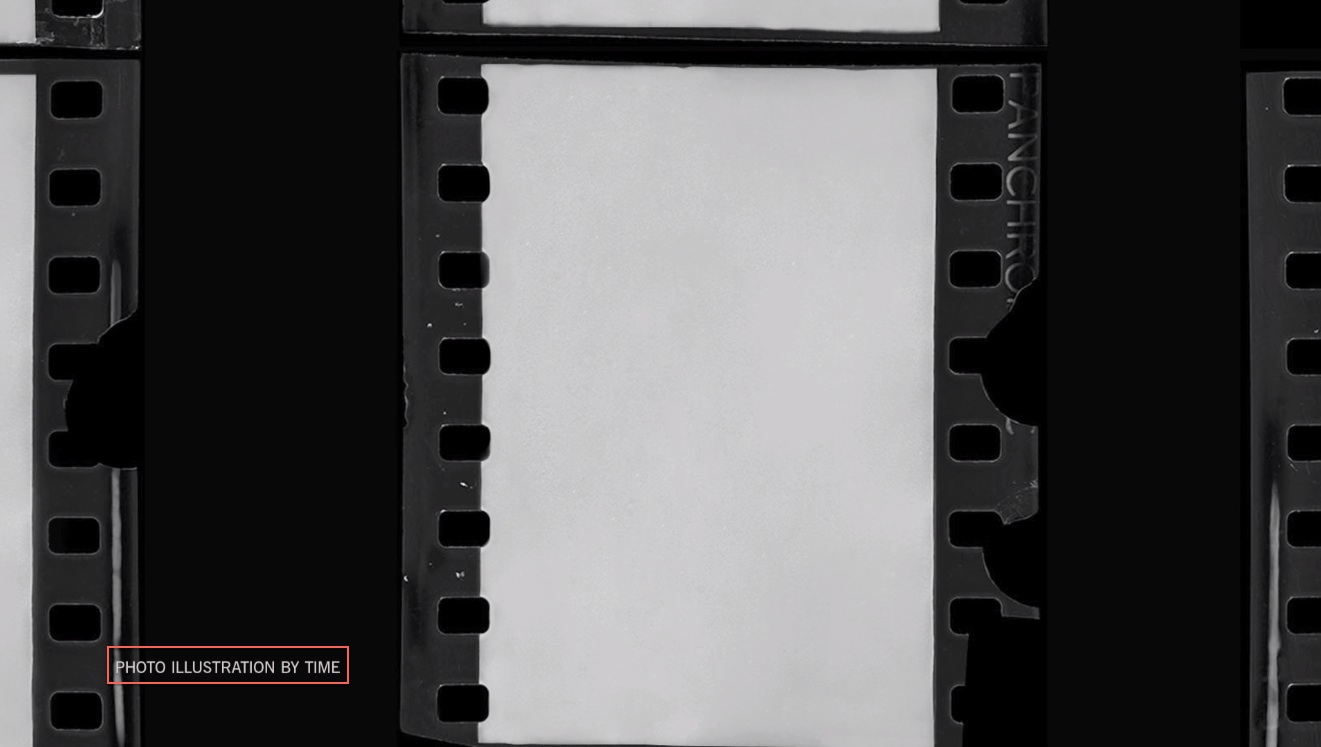
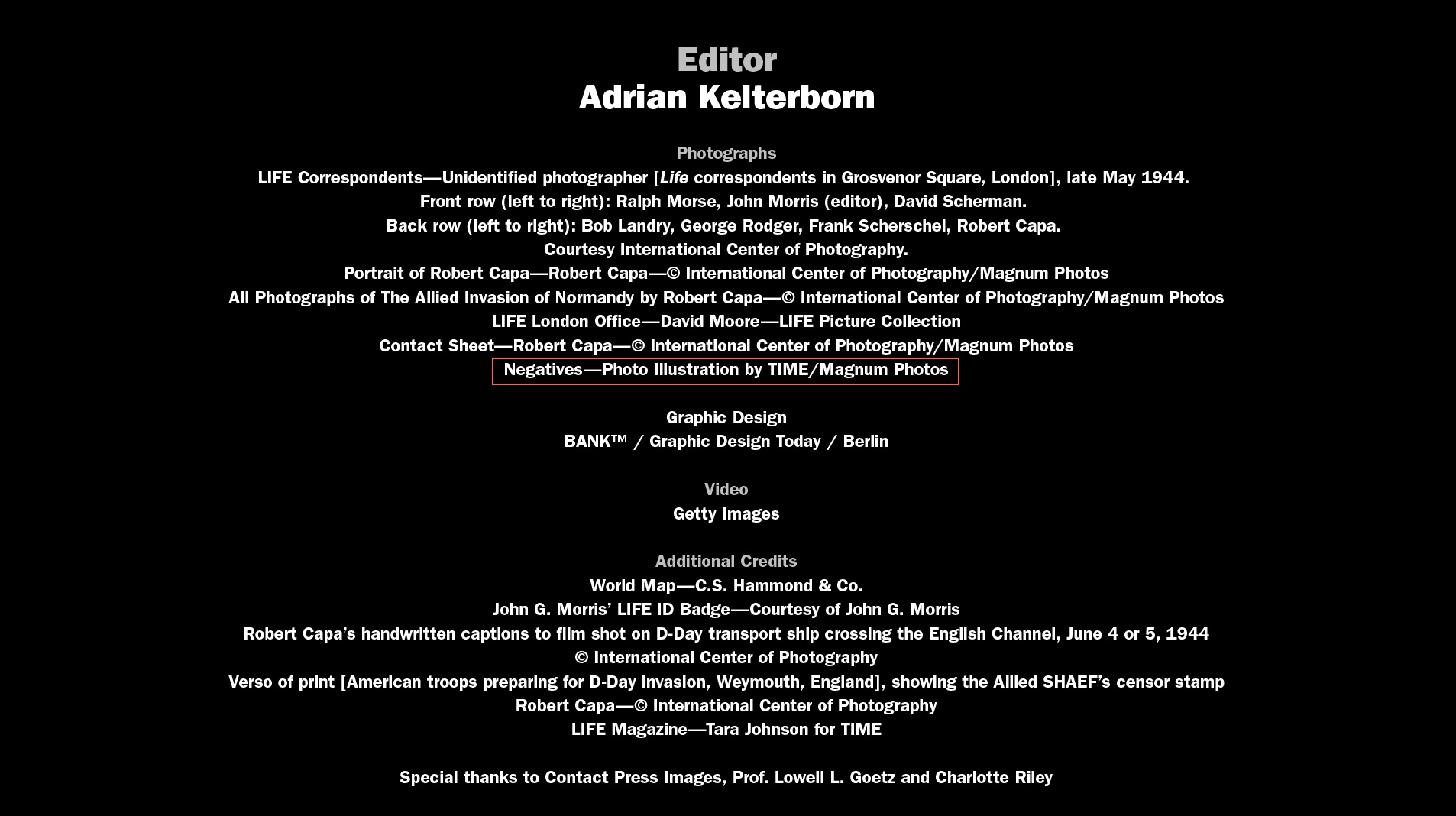
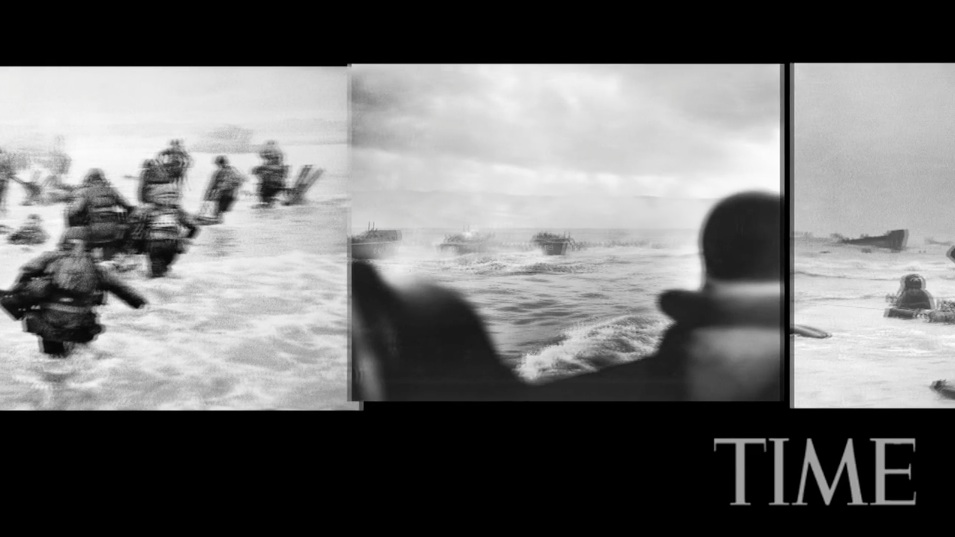
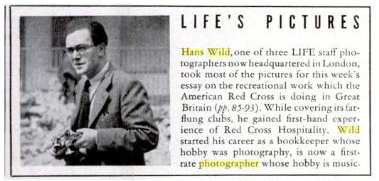





Thanks for looking into Capa’s iconic shot. Great project.
No, I don’t understand subscribers dropping out over one topic. It shows a small minded mentality. So what if you take up a topic that is not liked. I will delete and wait for your next gem. No one produces work that is liked by all. In this case the Capa project holds great importance and a determination, as best as could be done, would be greatly appreciated
Best Regards,
Daniel Teoli Jr.
A lot of people here are on the defensive – and bent out of shape for being identified as part of a long-term cover up. Jeez, too busy to deal with this issue, like it’s going to go away and nobody cares/will notice anyway? Downright stupid.
Careers (past, present, future) are, and will be, tainted by this little fiasco. An unfortunate mistake, compounded by a clumsy lie that must assume a general ignorance of technology along with the assumption of the artist’s and publisher’s irrefutable integrity to work, has provided the foundations of powerful institutions and cultural myths.
Poor Ingrid Bergman, can’t fault her for believing her lover’s story … but why should we, in the cold light of day? The real story is the ongoing institutional fraud, the curatorial incompetence, and (relentless) technological misinformation propagated over 4 generations.
Colleen
Very interesting and — in my view — has the making of what I’d call an anti-biography.
Photo interest. Historical interest. 70th anniversary WW2 interest.
Doug